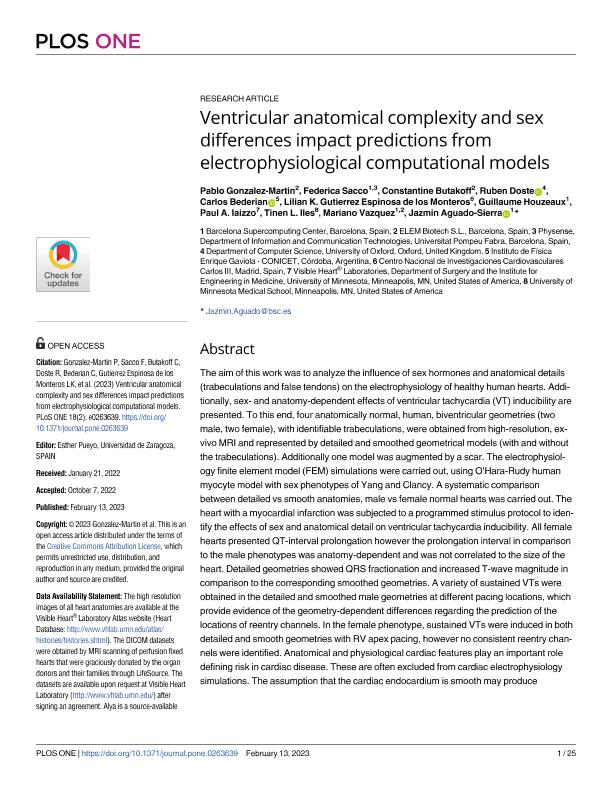Artículo
Ventricular anatomical complexity and sex differences impact predictions from electrophysiological computational models
Gonzalez Martin, Pablo; Sacco, Federica; Butakoff, Constantine; Doste, Ruben; Bederian, Carlos Sergio ; Gutierrez Espinosa de los Monteros, Lilian K.; Houzeaux, Guillaume; Iaizzo, Paul A.; Iles, Tinen L.; Vazquez, Mariano; Aguado Sierra, Jazmin
; Gutierrez Espinosa de los Monteros, Lilian K.; Houzeaux, Guillaume; Iaizzo, Paul A.; Iles, Tinen L.; Vazquez, Mariano; Aguado Sierra, Jazmin
 ; Gutierrez Espinosa de los Monteros, Lilian K.; Houzeaux, Guillaume; Iaizzo, Paul A.; Iles, Tinen L.; Vazquez, Mariano; Aguado Sierra, Jazmin
; Gutierrez Espinosa de los Monteros, Lilian K.; Houzeaux, Guillaume; Iaizzo, Paul A.; Iles, Tinen L.; Vazquez, Mariano; Aguado Sierra, Jazmin
Fecha de publicación:
02/2023
Editorial:
Public Library of Science
Revista:
Plos One
ISSN:
1932-6203
Idioma:
Inglés
Tipo de recurso:
Artículo publicado
Clasificación temática:
Resumen
The aim of this work was to analyze the influence of sex hormones and anatomical details (trabeculations and false tendons) on the electrophysiology of healthy human hearts. Additionally, sex- and anatomy-dependent effects of ventricular tachycardia (VT) inducibility are presented. To this end, four anatomically normal, human, biventricular geometries (two male, two female), with identifiable trabeculations, were obtained from high-resolution, ex-vivo MRI and represented by detailed and smoothed geometrical models (with and without the trabeculations). Additionally one model was augmented by a scar. The electrophysiology finite element model (FEM) simulations were carried out, using O’Hara-Rudy human myocyte model with sex phenotypes of Yang and Clancy. A systematic comparison between detailed vs smooth anatomies, male vs female normal hearts was carried out. The heart with a myocardial infarction was subjected to a programmed stimulus protocol to identify the effects of sex and anatomical detail on ventricular tachycardia inducibility. All female hearts presented QT-interval prolongation however the prolongation interval in comparison to the male phenotypes was anatomy-dependent and was not correlated to the size of the heart. Detailed geometries showed QRS fractionation and increased T-wave magnitude in comparison to the corresponding smoothed geometries. A variety of sustained VTs were obtained in the detailed and smoothed male geometries at different pacing locations, which provide evidence of the geometry-dependent differences regarding the prediction of the locations of reentry channels. In the female phenotype, sustained VTs were induced in both detailed and smooth geometries with RV apex pacing, however no consistent reentry channels were identified. Anatomical and physiological cardiac features play an important role defining risk in cardiac disease. These are often excluded from cardiac electrophysiology simulations. The assumption that the cardiac endocardium is smooth may produce inaccurate predictions towards the location of reentry channels in in-silico tachycardia inducibility studies.
Palabras clave:
Heart
,
Tachycardia
Archivos asociados
Licencia
Identificadores
Colecciones
Articulos(IFEG)
Articulos de INST.DE FISICA ENRIQUE GAVIOLA
Articulos de INST.DE FISICA ENRIQUE GAVIOLA
Citación
Gonzalez Martin, Pablo; Sacco, Federica; Butakoff, Constantine; Doste, Ruben; Bederian, Carlos Sergio; et al.; Ventricular anatomical complexity and sex differences impact predictions from electrophysiological computational models; Public Library of Science; Plos One; 18; 2-2023; 1-25
Compartir
Altmétricas



